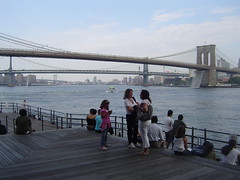Quantifying the Evolution of the Attractiveness of the NYC Waterfront
Posted: October 22nd, 2008 | No Comments »Today’s New York City mayor Michael Bloomberg announcement of the New York City Waterfalls economic impact marked the end of an intensive project I led over the summer at the MIT SENSEable City Lab. With innovative analysis of digital footprints to describe the evolution of the attractiveness of the Lower Manhattan and Brooklyn waterfront, we contributed to augment a study that used more traditional means (i.e. manual counts and surveys) to quantify who was attracted by the Waterfalls public art exhibit and how much money they spent. Our approach relied on several “indicators of urban attractiveness” inspired from financial indicators and network theory. For instance, in collaboration with Andrea Vacarri, we compared the attractiveness of the main points of interests in New York from the relative strength based on the density of digital footprints; or the evolution of the centrality of the waterfront among the network of points of interest generated by the flows of visitors in the Lower Manhattan area. The mapping of this new type of digital footprint analysis shows the impact of an event to open-up and drive people to new parts of a city over time.

Evolution of the flows of photographers in proximity to the exhibit from the analysis of photos generated between June and October in 2006 and 2007 and June and August 15 in 2008
Besides generating these preliminary research outcomes, there was a lot to learn from running digital footprinting techniques in parallel from traditional studies. The unconventional aspect of this type project leads a city to unbeaten territories where administrative procedure must be created. The data sets and methods must constantly be clearly explained. Liability and privacy issues are the obvious subject that necessitate constant clear descriptions of the data sets and methods used. Of course, in exploratory research that aims at developing the latter, this is not always evident, particularly with tight time constraints. In addition, the applied aspect of this research requests skills to communicate the value of the analysis for the present and the future. A situation I was already confronted in Florence when presenting research results to local authorities and journalists.


People generating digital footprints and digital shadows this summer in proximity to the NYC Waterfalls
Relation to my thesis: Research outcomes of this work will fit to the core of my dissertation. The overall experience of leading a digital footprint study to quantify the evolution of the attractiveness of an urban space fit with my interest in developing mixed methods to perform post-occupancy evaluations in the future. Unfortunately, in this project I could only rely only on very little qualitative observations.

